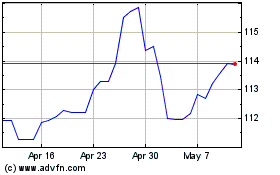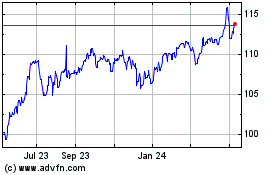Canadian Dollar Advances On Higher Oil Prices
September 20 2017 - 3:25AM
RTTF2
The Canadian dollar strengthened against its most major
counterparts in the European session on Wednesday amid rising oil
prices, as an industry data showed that U.S. crude inventories rose
less than expected last week.
Crude for November delivery rose $0.56 to $50.48 per barrel.
Data from the American Petroleum Institute showed a build of 1.4
million barrels in U.S. crude stockpiles last week, well short of
expectations for an increase of 2.925 million barrels.
Official data from the Energy Information Administration is due
later in the day, with analysts expecting a build of 2.4 million
barrels in crude inventories.
Market participants await a meeting between OPEC and non-OPEC
producers in Vienna on Friday to review compliance with the output
cut deal.
The Fed concludes its 2-day meeting later in the day, with many
expecting no change in interest rates.
That said, the accompanying statement may offer the details of
how the central bank plans to start shrinking its $4.5 trillion
balance sheet.
The loonie showed mixed performance in the Asian session. While
the currency fell against the aussie and the euro, it rose against
the greenback. Against the yen, it held steady.
The loonie climbed to 1.4692 against the euro, after having
fallen to 1.4759 at 10:15 pm ET. The next possible resistance for
the loonie is seen around the 1.45 region.
Data from Destatis showed that Germany's producer prices
increased at the fastest pace in three months in August.
Producer prices increased 2.6 percent year-on-year in August,
faster than the 2.3 percent rise seen in July.
The loonie hit a 2-day high of 1.2236 against the greenback,
following a decline to 1.2302 at 8:15 pm ET. If the loonie rises
further, 1.21 is likely seen as its next resistance level.
The loonie edged up to 90.95 against the Japanese yen, compared
to 90.77 hit late New York Tuesday. Continuation of the loonie's
uptrend may see it challenging resistance around the 93.00
region.
Data from the Ministry of Finance showed that Japan posted a
merchandise trade surplus of 113.642 billion yen in August.
That beat forecasts for a surplus of 104.4 billion yen, although
it was down from 418.8 billion yen in July.
On the flip side, the loonie held steady against the aussie,
following a 2-week decline to 0.9878 at 2:30 am ET. The pair
finished Tuesday's trading at 0.9844.
Data from the Westpcac Institutional Bank showed that
Australia's leading index remained in negative territory for the
third successive month in August.
The Westpac-Melbourne Institute Leading Index, which indicates
the likely pace of economic activity relative to trend three to
nine months into the future, dropped to -0.19 percent in August
from -0.04 percent in July.
Looking ahead, U.S. existing home sales data for August and
crude oil inventories data are slated for release in the New York
session.
CAD vs Yen (FX:CADJPY)
Forex Chart
From Mar 2024 to Apr 2024

CAD vs Yen (FX:CADJPY)
Forex Chart
From Apr 2023 to Apr 2024
